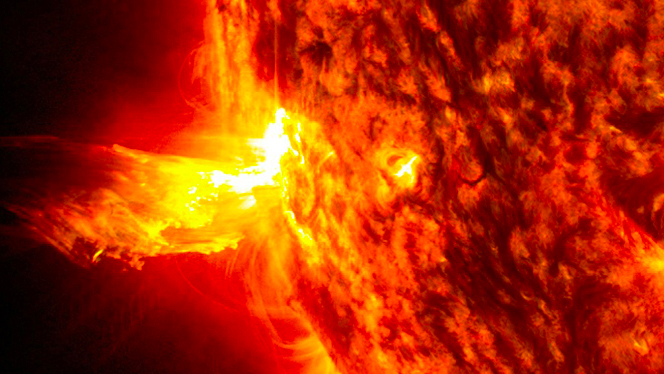Unexpected solar flare smashes into Earth, causing radio blackouts in Australia and New Zealand
The flare was accompanied by a coronal mass ejection that missed Earth

A surprise solar flare has burst from an area of dense magnetism on the sun’s surface, causing a temporary radio blackout in parts of Australia and all of New Zealand.
The M5-class, medium-strength solar flare was recorded by NASA's Solar Dynamics Observatory as it erupted from the sunspot AR3141 at 7:11 p.m. ET on Sunday (Nov. 6). The flare created a rush of radiation that ionized Earth’s atmosphere, according to spaceweather.com.
Sunspots are dark regions on the sun's surface where powerful magnetic fields, created by the flow of electrical charges, knot into kinks before suddenly snapping. The resulting release of energy launches bursts of radiation called solar flares and explosive jets of solar material called coronal mass ejections (CMEs). A CME did accompany this flare, but it was not aimed at Earth.
The solar flare erupted unexpectedly and took scientists by surprise. "Our apologies there was no alert for this event. The flare was impulsive,” the solar activity tracking website SpaceWeatherLive wrote on Twitter.
The National Oceanic and Atmospheric Administration (NOAA) classifies solar flares in five categories — A, B, C M and X — based on the intensity of the X-rays they release, with each level having 10 times the intensity of the last.
Once they reach Earth, X-rays and ultraviolet radiation produced by solar flares ionize atoms in our upper atmosphere, making it impossible to bounce high-frequency radio waves from them and creating a radio blackout. Radio blackouts occur over the areas lit by the sun during the time of the flare, and they are classified from R1 to R5, according to severity. This most recent flare caused a moderate R2 blackout.
Sign up for the Live Science daily newsletter now
Get the world’s most fascinating discoveries delivered straight to your inbox.
Solar activity, which astronomers have tracked since 1775, rises and falls according to a roughly 11-year cycle. Solar activity has been especially high recently, with sunspot numbers nearly twice those of NOAA predictions.
The increased activity has sent waves of high-energy plasma and X-ray bursts slamming into Earth's magnetic fields, downing Starlink satellites, triggering radio blackouts and causing auroras as far south as Pennsylvania, Iowa and Oregon.
And many more flares will likely lash Earth in the coming years. The sun's activity is projected to steadily climb, reaching an overall maximum in 2025, before decreasing again.
This ramp-up in activity means that, on the night of a solar storm, the northern lights will be visible much farther south than usual. This is because Earth's magnetic field gets compressed slightly by the waves of highly energetic particles, which ripple down magnetic field lines and agitate molecules in the atmosphere. This then releases energy in the form of light to create colorful shifting curtains in the night sky.

Ben Turner is a U.K. based staff writer at Live Science. He covers physics and astronomy, among other topics like tech and climate change. He graduated from University College London with a degree in particle physics before training as a journalist. When he's not writing, Ben enjoys reading literature, playing the guitar and embarrassing himself with chess.










